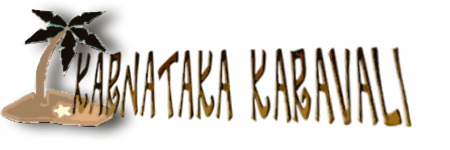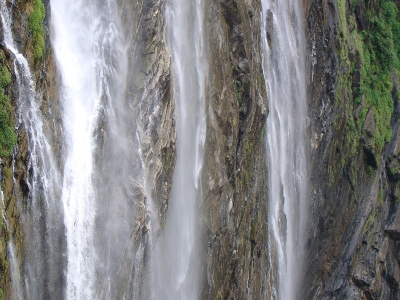*Yakshagana:* The YAKSHAGANA, a form of rich folk dance – drama is an unsurpassed way of exhibiting the themes taken from the epics. Though it can be regarded as a form of folk art, it is far more comprehensive, illuminating and trustworthy than any other form of folk art. Over the ages, Yakshagana has been the vehicle of arts, culture and didactic instruction in the rural areas.
The term ‘gana’ signifies music and as such Yakshagana means a particular style of music, with characteristics of its own, distinct from the other two types Indian music, Hindustani and Karnataka. In course of time, plays in this style came to be known as ‘Yakshagana Prasangas’.Click on Image to Enlarge
**
*Costumes and Makeup:*Yakshagana, as a medium of presenting the religious appeal through the depiction of various events, from the epics like Mahabharata and Ramayana, includes the characters that we never come across in real life. The Gods, divinities, demons, avatars or the incarnation of Gods and Goddesses, takes the viewer to a distinct dream world. The costumes and makeup are the creations of the creative genius, which totally leads the viewer on real life like imagination. The mythological characters are depicted with elaborate costumes and makeup.
A few Categories on types of costumes and makeup can be classified as,
* Valiant heroes or warriors like Karna, Arjuna, Gods and God incarnates which depict great battles fought and deeds of honor
* Characters such as Indra, Gaya etc. too valiant, quite often flamboyant, vain or even silly
* Rakshasas and Rakshasis (Demons) who signify strength, valor etc. but evil and cruel by nature. More often they are personalities which strike terror into the hearts of people
* Gods and Goddesses who take up destructive roles in order to crush evils and sin, when everyone else has failed to control the evil like Durga, Chandi, and Narasimha etc.
* Intermediate characters, which are beasts in, shape but very human in nature like Hanuman, Vali, and Janbava etc.
* Sages, Gurus and Brahmins
* Hasyagara (Hanumanayaka) who appears mostly as a servant or messenger and is a person of mundane realistic garb.
Headgears consist of crowns particularly built up mundasas, or turbans. These crowns are made of wood set which rich decorative materials consisting of bits of mirror and gold/silver paper. The crown is a symbol of sovereignty and normally all kings wear them. There is a second type of crown worn by demonical roles, which is large in size and having different decorative patterns consisting of Gold foil, a colored plate disc in front along with ear ornaments. It may be remembered that large number of headgears like the Rakshasa are quite heavy to carry. It is extremely difficult to carry these weights and intricate dance movements.
Many Yakshagana performances are staged in open air during the night and are also recognized by the name Dashavatara Ata or Bayalata. Ata in Kannada means play. The play begins with a prologue called ‘Sabhalakshana’. By the time ‘Sabhalakshana’ comes to an end, the village audience would all have gathered and it is time to start the ‘Prasanga’. The performance continues till the break of dawn. The stage is constructed in an open area like paddy field or temple yard and is a place easily accessible to all. This stage is called as ‘Rangasthala’.
Behind the stage is a raised bench, or a table or two, are placed for the ‘Bhagavata’ and his accompanists called ‘Himmela’. At the right hand corner sits the man who plays ‘Chende’. Chende is a high-strung drum played with two sticks and can be heard from a great distance. A drummer giving a vibrant background to the entire show also plays another drum known a ‘Maddale’.
In Yakshagana, it has been the custom from time immemorial, for the males to play both male and female roles. The Bhagavata is an anchorperson of Yakshagana performance; traditionally he is a leader of the troupe. He is also responsible for discipline, control among the artists and guides the artists about the script or Prasanga, the background story and the role of each character and their responsibilities.
**
*Kola – Ritual Theatre: *The Tulu speaking people of South Kanara have preserved their distinct culture, language and social values which can be widely seen even today. The folk rituals and beliefs reflect the socio-economic order, artistic values and culture connected to the ancient society. The ‘Bhotha Kola’ or the spirit worship is an important socio cultural phenomenon of South Kanara. As a possession cult and folk ritualistic theatre it is to be viewed as a complex system of rituals and beliefs, music and narratives, dance and dialogues, social gatherings and entertainment, miraculous healing of physical and mental disorders and setting of disputes and quarrels all rolled into one.Click on Image to Enlarge
Click on Image to Enlarge
‘Bhotha’ is a Sanskrit term signifying the elements of nature earth, water, fire, air and space. It also means the unseen spirit. With this in mind people began worshipping, a practice known as ‘Bhoothaaradhane’. It is not just an elaborate ritual but is also a rich form of visual and performing arts, which is associated with this cult. The spectacular dance by the priest-impersonator possessed by the spirit wearing gorgeous costumes, masks, making awe inspiring cries and performing miracles and heroic feats and delivering the message of the divine spirit, curing disease and settling village disputes – all these leave a lasting impression on the spectators. It is believed that ‘Bhootha’ or the spirit treats human beings as their foster children and act as a bridge between human beings and God. In return they expect their devotion and customary offerings.
The origin of this cult can be traced to the concepts of totemism and ancestor worship. Some spirits are of animistic origin while certain others are the legendary heroes or other historical figures, which met with tragic death and hence attained divinity.
Spirits like Panjurli, Pilichandi and Nandigone indicate their totemistic origin from pig, tiger and bull. Jumadi, Mariamma etc. are connected with puranic deities. Jumadi is considered half male and half female. There are also certain other spirits of native origin like ‘Koti Chennaya’, ‘Kalkuda’ Bobbarya and ‘kordabbu’ etc. ‘guliga’ and Chaundi’ are ferocious spirits and in the ceremonies associated with them, sucking of live blood from chicken may be observed. There are about four to five hundred spirits, but only twenty-five are more popular and worshipped in all parts of South Kanara. Other spirits are worshipped by certain individual families or in certain regions in a modest way.
**
*Pad-danas -* *Oral epics*:* *Narrated in Tulu language, Pad-danas refer to historical and mythological events of the region at different periods, thereby serving a useful source of information to a historian. Pad-danas are narrated in ballad-loke folk epics of varying length. These ballads, which were handed over through oral traditions, arepics pl especially sung especially by the community of impersonators together with the rhythmic beats of a small drum known as ‘tembare’.
The folk form and music in the ritual art of Bhoothakola is very prominent and contribute significantly to the cultural edifice of folk arts. The impersonators are born singers and they inherit the knowledge of melody and rhythm and undergo training in voice culture with their parents. The Pad-danas are sung in high octave in front of the image of the spirit. Musicians form an integral part of the whole ritualistic performance. Only men act as spirit impersonators even in the case of female spirits.Click on Image to Enlarge
*Nagaaradhane – Serpent Worship:*In coastal Karnataka, both Tulu speaking areas as well as Kannada speaking areas, Serpent worship is performed with great pomp and reverence. The propitiation of serpent is believed to give them wealth, health and offspring’s. Stone slabs with figures of serpents carved on them are installed and worshipped in a bush, or under a tree.
Apart from the periodical worship of these serpent stones, the devotees also arrange for a big ritual called ‘Nagamandala’, to fulfill their vows, to obtain desired boons and for the welfare of the community. A representation of serpent spirit is made on the floor by using powders of different colors. These colors are made from indigenous objects such as dried leaves, saffron and rice powder etc. The picture of the serpent will represent several hoods in odd numbers along with wavy movements of the serpent body. This ceremony beginning at around 9.00pm lasts throughout the night. The two important characters in the ballet like dance drama are the ‘Nagapaatri’ possessed by the serpent spirit and the other in the role of serpent maiden ‘ Nagakannike’. The craftsmanship involved in deep and fascinating color combination of the madala design, the terrific as well as graceful dance drama of the Naga artists accompanied by music, final oracle and divine message create a lasting impression on the minds of the devotees.


















































